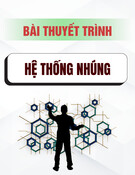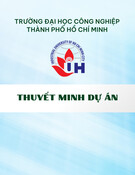
Chung Tan Lam, Tran Dinh Dat
A SIMPLE PATH TRACKING CONTROL
OF TWO-WHEELED MOBILE ROBOT
Chung Tan Lam, Tran Dinh Dat
Posts and Telecommunications Institute of Technology
Abstract: In this paper, a nonlinear path tracking
controller based on a combination of kinematics and
torque backstepping methods is applied to a
nonholonomic Two-Wheeled Mobile Robot (WMR). The
mobile robot is considered in terms of dynamics model in
Cartesian coordinates and its parameters are exactly
known. To achieve the controller, the tracking errors are
defined, the control inputs for the kinematics controller
are designed, and the torque controller is designed to
guarantee that the errors converge to zero asymptotically.
The simulation results are included to illustrate the
performance of the control law.
Keywords: Wheeled Mobile Robot (WMR), path
tracking, backstepping.
I. INTRODUCTION
Mobile robots have been studied and are increasingly
applied in practical fields: industry manufacturing,
medical services, military tasks, house operations,
planetary exploration, entertainment, and so forth.
Robotics research is highly interdisciplinary requiring the
integration of control theory with mechanics, electronics,
artificial intelligence, communication and sensor
technology.
For mobile robots control strategies, the navigation
problem is one of the most important operations. It may
be divided into three basic problems: trajectory tracking,
path following and point stabilization. Much of research
have been written about solving the motion problem of the
above under nonholonomic constraints using kinematics
model of a mobile robot; some others, about the of
integration of the nonhonomic controller and the
dynamics of the mobile robot; less others still have been
focused on robustness and control in presence of
uncertainties in the dynamical model
In literature, Fierro et al., developed a combined
kinematics and torque control law using backstepping
approach, and asymptotic stability is guaranteed by
Lyapunov theory; particularly, a general structure for
controlling a mobile robot was derived. The structure can
accommodate difference control techniques, from
conventional computed-torque controller to robust-
adaptive controller [3]. T. Fukao et al., proposed the
integration of a kinematics controller and a torque
controller for the dynamic model of a nonholonomic
mobile robot with unknown parameters of the wheels [6].
Jung-Min Yang et al., 1998, proposed a new sliding mode
control which is robust against initial condition errors,
measurement disturbances and noise in the sensor data to
asymptotically stabilize to a desired trajectory by means
of the computed-torque method [4]. Additionally, it is
clear that the mobile robot requires accurate sensing of the
environment, intelligent trajectory planning, and high
precision control.
In this paper, the trajectory tracking problem for a
two-wheeled mobile robot is considered. This is the first
step of the development of an intelligent indoor mobile
robot. A backstepping control approach is applied to
design a controller in terms of dynamics model: first,
feedback velocity control inputs are designed for the
kinematics steering system to make the position errors
asymptotically stable; then, a computed-torque controller
is design such that the mobile robot’s velocities converge
to the given velocity inputs. The simulation results have
been done to show the effectiveness of the proposed
controller.
II. MOBILE ROBOT MODELLING
In this section, the dynamics of a two-wheeled mobile
robot is considered with the nonholonomic constraints in
relation with its coordinates and the reference path.
A. A Nonholonomic Two-Wheeled Mobile Robot
A mobile robot system having an n-dimensional
configuration space with generalized coordinates
1
( ,..., )
n
qq
and subject to
m
constraints can be described
by [3]
( ) ( , ) ( ) ( ) ( ) ( )
T
d
M q q V q q q F q G q B q A q
+ + + + = −
(1)
where
() nxn
M q R
is a symmetric and positive definite inertia
matrix,
( , ) nxn
V q q R
is the centripetal and coriolis
matrix,
1
() nx
F q R
denote the surface friction,
1
() nx
G q R
is the
gravitational vector,
d
denotes bounded unknown
disturbance including unknown unstructured
dynamics,
() nxr
B q R
is a input transformation
matrix,
1rx
R
is the control input vector,
() mxn
A q R
is
the matrix related with nonholonomic constraints,
and
1mx
R
is the vector of constraint forces.
We consider that all kinematics equality constraints are
independent of time, and can be expressed as follows:
Contact author: Chung Tan Lam
Email: lamct@ptithcm.edu.vn
Manuscript received: 5/2023, revised: 6/2023, accepted: 7/2023.
No. 03 (CS.01) 2023
JOURNAL OF SCIENCE AND TECHNOLOGY ON INFORMATION AND COMMUNICATIONS 75

A SIMPLE PATH TRACKING CONTROL OF TWO-WHEELED MOBILE ROBOT
( ) 0A q q =
(2)
Let
()Sq
be a full rank matrix
()nm−
formed by a set of
smooth and linearly independent vector fields spanning
the null space of
()Aq
, that is,
( ) ( ) 0
TT
S q A q =
(3)
According to (2) and (3), it is possible to find an auxiliary
velocity vector
mn
Rv −
such that
()q S q v=
(4)
The model of two-wheeled mobile robot shown in Fig.
1 is of a typical nonholonomic system. The mobile robot
has two driving wheels mounted on the same axis, and
one rear wheel. The posture of the mobile robot can be
described by three generalized coordinates:
T
yxq
=
We assume that the wheels are purely rolling and do
not slip, that is, the robot can only move in the direction
normal to the axis of the driving wheels. Analytically, the
mobile base satisfies the following condition [3]
cos sin 0yx
−=
(5)
The kinematics equations of motion in terms of linear
velocity and angular velocity of the mobile robot are
cos 0
sin 0
01
xv
y
=
(6)
where
max
vv
and
max
;
max
v
and
max
are the
maximum linear and angular velocities of the mobile
robot.
Figure 1. Mobile platform configuration
B. Structural properties of a mobile platform
The system (1) is now transformed into a more
appropriate representation for control purposes.
Differentiating Eq. (4), substituting the result into Eq. (1),
and then multiplying by
T
S
, we can eliminate the
constraint matrix
()
T
Aq
. Therefore, the complete
equations of motion of the nonholonomic mobile
platform are given by
.q S v=
(7)
()
T T T
md
S MSv S MS V S v F S B
+ + + + =
(8)
Eq. (8) can be rewritten as follows
( ) ( , ) ( )
md
M q v V q q v F v B
+ + + =
(9)
B
(10)
where
() rxr
M q R
is a symmetric, positive definite inertia
matrix,
( , ) rxr
V q q R
is the centripetal and coriolis matrix,
1
() rx
F v R
is the surface friction,
d
denotes bounded
unknown disturbances including unstructured unmodeled
dynamics, and
1rx
R
is the input vector. If
r n m=−
, it
is easy to verify that
B
is a constant nonsingular matrix
that depends on the distance between the driving
wheels
R
and the radius of the wheel
r
.
The complete dynamics system consists of the
kinematics system (7) and an extra dynamics (8). Let
u
be an auxiliary input, then by applying the nonlinear
feedback
1
( , , , )
( )[ ( ) ( , ) ( )]
m
f q q v u
B q M q u V q q v F v
−
=
= + +
(11)
Substituting parameters of the mobile robot platform, Eq.
(11) becomes [7]:
1
22
1
22
1
1
2
ww
rw
lw
ww
c
r r b
m I I I
r b r u
r r b
m I I I
r b r
b
rm d v
b
b
++
= = +
+ − −
−
−−
22
2
22
cw
c w c m
m m m
I m d m b I I
=+
= + + +
(12)
where
rw
and
lw
: the motors’ torques which act on the right
and the left wheels;
c
m
and
w
m
are the mass of body and
wheel with a motor;
d
is the distance between the
geometric and mass center of WMR;
c
I
is the inertia
moments of the body about the vertical axis through
WMR mass center;
w
I
, inertia moment of the a wheel
and motor about the wheel axis;
m
I
, inertia moment the
wheel with the motor about the wheel diameter.
It is possible to convert the dynamic control problem
into the kinematics control problem.
()q S q v
vu
=
=
(13)
Eq. (13) represents a state-space description of the
nonholonomic mobile robot. To make use of (13), it is
assumed that all the dynamical
quantity
)q(M
,
)v(F
,
)q,q(V
of the mobile robot are
No. 03 (CS.01) 2023
JOURNAL OF SCIENCE AND TECHNOLOGY ON INFORMATION AND COMMUNICATIONS 76

Chung Tan Lam, Tran Dinh Dat
exactly known and disturbance
0
d=
.
Defining
vT
TT
xq
=
, Eq. (13) can be rewritten as
( ) ( )x f x g x u=+
C. Path Tracking Problem
Let a reference mobile robot be prescribed as
cos , sin ,
,
r r r r r r r r
TT
r r r r r r r
x v y v
q x y v v
= = =
==
(14)
Find a smooth angular velocity control input
( ) ( , , )
p p p r
v t f e v K=
such that
lim( ) 0
r
tqq
→ −=
, where
p
e
,
r
v
and
K
are the tracking errors, the reference velocity
vector, and the controller gain vector, respectively. Then,
compute the torque input
()t
for (1), such that
p
vv→
as
t→
.
The point
( , )
pp
P x y
can be derived from
( , )Po x y
:
=
+=
+=
p
p
p
sindyy
cosdxx
(15)
e3
),,( rrr yx
),y,x( ppp
r
),( rr yx
Reference path
d
2r
xp
P
b
R
X
Y
e1
e2
xxr
y
yp
yr
x
y
L
Po
C
Figure 2. Scheme for deriving WMR kinematics equations
where
d
is the distance between
P
and
Po
. The
derivative of (15) yields
=
+=
−=
p
p
p
cosdyy
sindxx
(16)
It is assumed that a reference point
)y,x(R rr
on the
reference path is moving at the constant velocity
of
r
v
with the orientation angle
r
. The dynamic equation
is shown below:
=
=
=
rr
rrr
rrr
sinvy
cosvx
(17)
where
r
is defined as the angle between
r
v
and x-axis
and
r
is the rate of change of
r
v
.
The relationship between
,v
and the angular velocities
of two driving wheels is the following:
1/ /
1/ /
rw
lw
r b r v
r b r
=
−
(18)
where
,
rw lw
represent the angular velocities of the
right and the left wheels,
b
is distance from WMR’s
center point to the driving wheel and
r
is the radius of
wheel.
III. PATH TRACKING CONTROLLER DESIGN
There are several approaches to select a velocity
control input
v
for the system (7). In this section, the
control
v
is converted into torque control
for the actual
physical mobile robot; that is to say,
in (11) is selected
so that (13) exhibits the desired behavior motivating the
specific choice of the velocity
v
. This allows the steering
system commands
v
to be converted to torques
that
take into account the mass, friction and others parameters
of the actual mobile robot.
The scheme of errors measurement is shown in Fig. 2.
The tracking errors
1 2 3
[ , , ]T
p
e e e e=
are defined as
following
1
2
3
cos sin 0
sin cos 0
0 0 1
rp
p r p
rp
e x x
e e y y
e
−
= = − −
−
(19)
The first derivative of errors yields
1 2 3
2 1 3
3
1 cos
0 . sin
01
r
p
r
p
r
e e v e
v
e e v e
e
−
= − +
−
(20)
The Lyapunov function candidate is chosen as
22 3
12
2
1 cos
11 0
22
o
e
V e e k
−
= + +
(21)
The derivative of
o
V
becomes
3
1 1 2 2 3
2
3
1 3 2 2
2
sin
sin
( cos ) ( )
o
p r r p r
e
V e e e e e
k
e
e v v e k e v
k
= + +
= − + + − +
(22)
To achieve
0
o
V
, we choose
3 1 1
2 2 3 3
cos
sin
pr
prr
vv e k e
k v e k e
+
=
++
(23)
where
12
,kk
and
3
k
are positive values.
To obtain the dynamic control (13), we have to find a
nonlinear feedback control
nm
uR
−
so that
p
vv→
as
t→
.
First, we define an auxiliary velocity errors
2
11
4
2
5
p
p
p
e v v
vv
e
vv
e
=−
−
=
−
(24)
where
No. 03 (CS.01) 2023
JOURNAL OF SCIENCE AND TECHNOLOGY ON INFORMATION AND COMMUNICATIONS 77

A SIMPLE PATH TRACKING CONTROL OF TWO-WHEELED MOBILE ROBOT
1
2
vv
vv
==
and
1
2p
p
p
p
p
v
v
vv
==
Define Lyapunov function
V
and its derivative as
following:
2
10
2
Ve=
V ee=
To achieve
0V
, we choose
eKe 4
−=
4()
pp
u v K v v = + −
(25)
Therefore, by making use of the acceleration control
input (25),
0e→
, or
p
vv→
, as
t→
.
where
4
K
is a positive definite diagonal matrix given by
44
K k I=
.
III. SIMULATION RESULTS
To verify the effectiveness of the proposed controller,
simulations have been done with the dynamics controller
(23) and the kinematics controller (25) to track a defined
reference smooth-curved path shown in Fig. 4. The
controller parameters
are
10.5k=
,
21000k=
,
30.05k=
and
450k=
. The input
disturbances are chosen to be 0. The WMR’s parameters
are known totally. The WMR’s parameters and the initial
values are given in TABLE 1. The speed of the mobile
robot is designed at 100 mm/s.
The simulation results are given through Figs. 4-8..
The linear velocity of the center varies in the vicinity of
100mm/s in Fig. 6. The posture and the tracking point
trajectory is shown in Fig. 9. The simulation results show
that a good tracking performance can be achieved by the
proposed controller.
In Fig. 4, it can be seen that the errors approach to zeros
after 6 seconds; also, as the robot passes through the
curved line there is a sudden change of
r
which, in turn,
make error
3
e
about 17 degrees.
TABLE I. The WMR’s parameters and initial values
Parameters
Values
Unit
(1) WMR’s parameters
b
0.105
m
d
0.08
m
R
0.025
m
c
m
10
kg
w
m
1
kg
w
I
3.75x10-4
kgm2
c
I
0.2081
kgm2
m
I
4.96x10-4
kgm2
(2) Initial values
r
x
0.28
m
p
x
0.27
m
r
y
0.4
m
p
y
0.39
m
r
0
degree
p
5
degree
v
0
mm/s
0
rad/s
R=0.2546
R=0.2546
(0.28,0.4)
(0.68,0.4)
(0.9346,0.6546)
(1.1893,1.3093)
(1.5893,1.3093)
(0.9346,1.0546)
X
Y
Figure 3. Reference trajectory
01684 20102 6 12 1612
Time (s)
-20
-15
-5
0
5
10
15
20
-10
Tracking Errors
Error e1 (mm)
Error e2 (mm)
Error e3 (deg)
Figure 4. Tracking errors
0.0 1684 20102 6 12 1612
Time (s)
Right wheel
Left wheel
0
20
60
80
100
120
40
Angular velocities (rpm)
Figure 5. Angular velocities of two wheels
Time (s)
01684 20102 6 12 1612
0
0.02
0.06
0.08
0.10
0.12
0.14
0.16
0.04
Linear velocity (m/s)
Figure. 6. Linear velocity of WMR’s center
No. 03 (CS.01) 2023
JOURNAL OF SCIENCE AND TECHNOLOGY ON INFORMATION AND COMMUNICATIONS 78

Chung Tan Lam, Tran Dinh Dat
01684 20102 6 12 1612
Time (s)
-0.6
-0.4
0
0.2
0.4
0.6
0.8
1.0
-0.2
Angular velocity (rad/s)
1.2
1.4
Figure 7. Angular velocity of WMR’s center
01684 20102 6 12 1612
Time (s)
-4
-2
2
4
6
8
10
0
Torques (Nm)
Right wheel
Left wheel
Fig. 8: Applied torques
MR’s center C
Reference trajectory
Tracking point P
Tracking trajectory
0.2
0.4
0.8
1.0
1.2
1.4
1.6
0.6
1.20.60.2 0.80 0.4 1.0 1.61.4
Time (s)
Fig. 9 WMR’s movement tracking reference path
The mechanical model of the mobile robot is
preliminary designed in the Fig. 13.
IV. CONTROL SYSTEM SCHEME
The control system scheme is based on the integration
of a computer-based vision and an STM32-based motion
controller. The image is processed using the computer
and the mobile robot’s wheels are drived via the motion
controller with a servo BLDC motor driver (Figs.11-12).
The configuration diagram of the total control system is
shown in Fig. 10. For the operation, the image is
processed to extract the feature of errors for the control
law. The result of the processing, the torque command, is
sent to the low level to control the mobile robot motion.
The designed system is available, but the real system are
not yet to finished at the time of this writing. The real
mobile robot, control hardware and the experiments will
be included in the future.
Figure 10. The configuration of the control system
Figure 11. Motion controller is based on STM32
Figure 12. BLDC motor driver
Figure 13. The model of the mobile robot
V. CONCLUSIONS
A simple nonlinear controller for a two-wheeled
mobile robot based on backstepping design method has
been introduced. The mobile robot is considered in terms
of dynamics with exactly known parameters. The
controller is stable in the sense of Lyapunov stability.
Also, a simple way of measuring the errors for deriving
the control law is proposed. The simulation results show
that the controller is possible to implement in the future.
No. 03 (CS.01) 2023
JOURNAL OF SCIENCE AND TECHNOLOGY ON INFORMATION AND COMMUNICATIONS 79



![Thiết kế sơ bộ robot chuyển động trong đường ống thủy lợi [chuẩn nhất]](https://cdn.tailieu.vn/images/document/thumbnail/2025/20250411/vimaito/135x160/2931744365389.jpg)
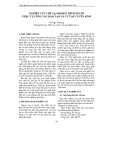

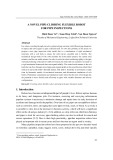
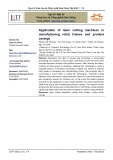

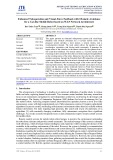
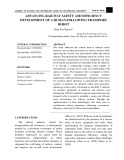

![Đề cương đề tài nghiên cứu khoa học [chuẩn nhất/mới nhất]](https://cdn.tailieu.vn/images/document/thumbnail/2025/20251117/duong297/135x160/26111763433948.jpg)










